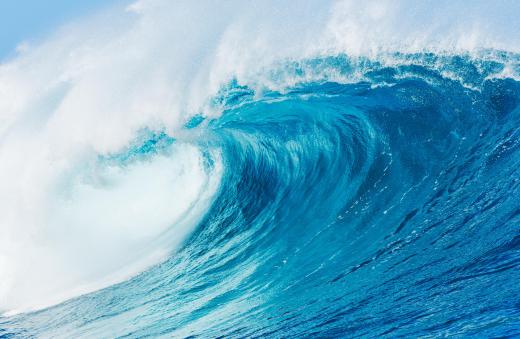What is a Tsunami Buoy?
 Mary McMahon
Mary McMahon
A tsunami buoy is a specialized buoy which is able to detect subtle changes in water pressure which could indicate an incoming tsunami. Tsunami buoys are placed at strategic locations all over the world to provide early warnings which can be used by authorities to determine the risk of a tsunami. Using data collected from tsunami buoys, authorities may order an evacuation or issue a warning, and they can sometimes estimate the height of the incoming tsunami.
Tsunamis are extremely large ocean waves caused by seismic and geological events such as earthquakes and volcanic eruptions. They are especially common around the Pacific Ocean, where active subduction zones generate numerous seismic events throughout the year. The most devastating tsunami in recent history occurred on 26 December, 2004, killing thousands of people around Southeast Asia. This event served as a catalyst for many nations to work on comprehensive tsunami warning systems which include tsunami buoys.

There are two main parts to a tsunami buoy: a pressure sensor and a companion buoy. The pressure sensor is anchored to the sea floor, and it contains a central processing unit and an acoustic transmitter. As a tsunami passes in the open ocean, the wave creates distinctive pressure changes which are recorded by the tsunami buoy's pressure sensor. The pressure sensor communicates with the surface buoy acoustically, and the companion buoy in turn sends the information to a satellite.

When a tsunami buoy detects a pressure pattern which could be a tsunami, it immediately sends information to the satellite, and the information is passed on to regional tsunami warning centers. These centers can also contact the buoy to request information, either to download general observations and data, or to address specific concerns after a seismic event which might trigger a tsunami.
Tsunami buoy technology has the potential to save lives by giving nations an early warning so that they can evacuate citizens and take precautions in coastal areas. Many nations cooperate when it comes to tsunami observation and monitoring, recognizing that early detection and warning is of mutual benefit. The United States, for example, has a string of tsunami buoys around the “ring of fire” in the Pacific, and it shares data from these buoys on request. People can even pick up real time buoy data from the National Oceanic and Atmospheric Administration's Deep-ocean Assessment and Reporting of Tsunamis program online, should they so desire.
AS FEATURED ON:
AS FEATURED ON:












Discussion Comments
The buoy itself is not able to detect anything. The most important part is the seabed high accuracy pressure sensor (Tsunameter). It collects sea level data, thousands meters deep, with millimeter accuracy and raises an alarm in case of detected tsunami wave.
The alarm and related data can be transmitted by very expensive underwater cables, like in Japanese system (JMA), or by acoustic modem like in most of the other low cost systems (from USA, Norway, Italy, UK).
The buoy only relays received acoustic data via satellite to the control center. Recently some efforts have been done to collect tsunami waves using high precision, multichannel, multi satellite GNSS. These systems consent to collect tide data but often drop the tsunami. It is the case of the Indonesian Tsunami Warning system built by the German GFZ (GITEWS).
can you please tell us how to get one of these things?
Post your comments